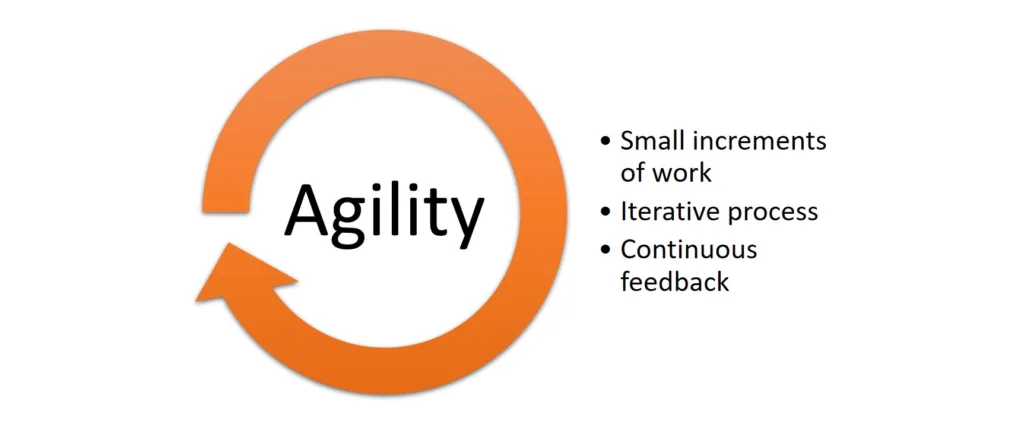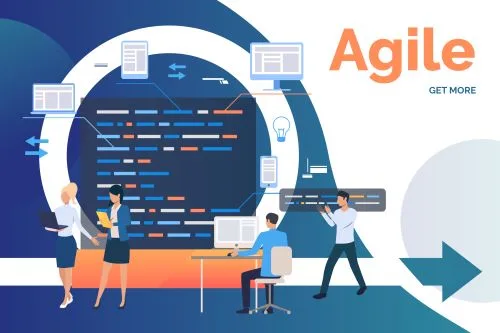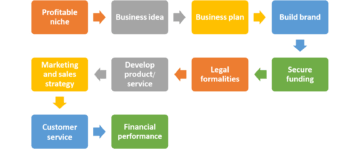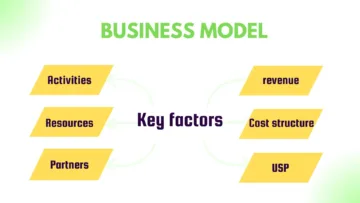Agile is a methodology that emphasizes flexibility, collaboration, and continuous improvement. Originally created with software development in mind, many businesses from all sectors have adopted it to enhance their operations and results. It’s critical for companies to be able to rapidly adjust and respond in the currently ever-changing business landscape to stay competitive and successful.
According to a recent survey, approximately 70% of companies have adopted an agile approach in business. This article will explore the significance of the Agile process and the steps to implement it efficiently.
- Understanding the Agile Business Process
- Why an Agile Process is Crucial for Your Business Success
- It helps businesses stay competitive by responding quickly to market changes
- Agile can increase employee morale and engagement
- Agility can help businesses identify and prioritize tasks based on customer needs and feedback
- It can reduce project risk and increase transparency in the project
- Agile can help businesses get products to market at a fast pace
- The Advantages of Implementing Agile in Your Business
- Ways to Adopt Agile Methodologies for Your Business
- Overcoming the Disadvantages of Agility in Business
- Strategies for a Successful Agile Business Transformation
- Measuring the Success of Your Business
Understanding the Agile Business Process

This process is a methodology that emphasizes flexibility and responsiveness to change. It originated in software development but can be applied to any industry or business vertical. The basic tenets of Agile include:
- Delivering small, functional increments of work rather than waiting for a complete solution
- Continuous feedback and collaboration among team members and stakeholders
- Iterative processes that allow for adjustments and improvements throughout the development cycle
It focuses on delivering value to the customer through a product that meets their needs and expectations. Agile teams prefer to break down their tasks into smaller, more manageable chunks and deliver them frequently as the project progresses. This approach allows for faster delivery of the end product with fewer delays. This approach lets stakeholders see progress and make changes throughout the development cycle, resulting in a product that better meets their needs.
It also emphasizes teamwork and collaboration. Cross-functional teams work together to complete projects, rather than siloed departments working on individual tasks. This approach can lead to better solutions and ideas.
Overall, the Agile process puts the customer at the center of development and focuses on delivering value quickly and efficiently.
If you want to learn about business models, read our article on the top 3 business models to watch out for.
Why an Agile Process is Crucial for Your Business Success
The agile approach can provide numerous benefits for your business. Here are some of the key reasons why it is crucial for a company’s growth:
It helps businesses stay competitive by responding quickly to market changes
Adapting swiftly to changing market scenarios is critical for businesses in order to survive and stay ahead of their competition. By being agile, companies can be more responsive to dynamic customer requirements and evolving market trends.
Read more, 9 ways to choose the right market for your business expansion.
Agile can increase employee morale and engagement
These methodologies emphasize collaboration, transparency, and self-organization. It means that employees are more involved in expanding the organization and have more opportunities to share their ideas and insights. Thus, it can lead to a more engaged and motivated workforce and a stronger sense of ownership and accountability.
Agility can help businesses identify and prioritize tasks based on customer needs and feedback
Agile frameworks like Scrum and Kanban place a strong emphasis on customer collaboration and feedback. It means that businesses can better understand customer needs and preferences. As a result, they can prioritize tasks and develop features that are most valuable to clients.

It can reduce project risk and increase transparency in the project
Agile methods rely on frequent feedback and iteration, which means that potential issues and risks are recognized and addressed early in the development cycle. This can reduce the risk of project failure and increase transparency and accountability throughout the development cycle.
Agile can help businesses get products to market at a fast pace
Traditional development methodologies often involve lengthy planning and development cycles, which can delay time-to-market and increase the risk of wasted resources. The agile strategy emphasizes delivering small, functional increments of work. Hence, businesses can generate value earlier and respond quickly to market opportunities.
The Advantages of Implementing Agile in Your Business

Improved Project Visibility and Forecasting
Agile provides a structure for increased visibility and forecasting, allowing businesses to plan more accurately. With Agile, companies can track the productivity of teams more effectively. Additionally, they can pinpoint and mitigate potential threats earlier in the development cycle.
Enhanced Collaboration and Cross-Functional Teams
It emphasizes collaboration and cross-functional teamwork, which can lead to better solutions and ideas. By involving team members from various departments, businesses can gain a more holistic view of their projects and make better-informed decisions.
Higher-Quality Products
With Agile, issues are recognized and addressed earlier, resulting in higher-quality products. Businesses can deliver products that meet customer needs and expectations by prioritizing frequent testing and continuous feedback.
Increased Customer Satisfaction
Agile methodology enables businesses to collect customer feedback and rank tasks in order of importance as per customer requirements. It helps companies deliver solutions that meet their customer’s expectations, thus resulting in a better satisfaction rate.
More Adaptable and Flexible Business Culture
Adopting the Agile approach can lead to a more adaptable and flexible business culture. By emphasizing continuous improvement and iteration, businesses can respond more quickly to market changes and make necessary adjustments to their processes and practices.
Ways to Adopt Agile Methodologies for Your Business
If you are convinced that Agile methodology can benefit your business, here are some tips on how to get started:

Start small and pilot the Agile process with a single team
This incremental approach can help you assess the effectiveness of the Agile methodology before scaling it up. Choose your most motivated and adaptable team to test the waters and ensure their goals align with your business objectives.
Provide training and support to employees
Not everyone will be familiar with Agile strategy. Ensure you offer them the resources they need to learn more about the Agile method and best practices for effective implementation.
Establish clear goals and metrics
Without clear goals, it will be difficult to tell whether your Agile initiatives are working or not. Establish what success looks like early on and track the metrics that matter most, such as team velocity, customer satisfaction, or time to market.
Define roles and responsibilities for Agile team members and stakeholders
Ensure everyone is on the same page while defining responsibilities, goals, and expectations. Clearly define who is responsible for what, and ensure everyone feels comfortable with their roles so that the Agile approach runs smoothly.
Adapt practices to fit the specific needs and challenges of your business
The Agile methodology is not one-size-fits-all. Adjust processes, practices, and tools to the unique challenges and needs of your business. Regularly review and refine your Agile delivery approach to get the most out of the methodology.
Overcoming the Disadvantages of Agility in Business
Here are some strategies for overcoming the disadvantages of Agile in business:
Addressing the Communication Challenge
It requires a high level of collaboration and communication between team members. It can be particularly challenging for remote teams, where in-person interactions may be limited. Businesses are now turning to online communication tools such as video conferencing and messaging apps to bridge the gap between team members, ensure collaboration, and foster connection.
Educating Stakeholders and Teams
Not all stakeholders may be familiar with the Agile process or understand its benefits. For that, businesses should educate their stakeholders and teams on the principles and practices of Agile. It includes providing training and support to help team members become familiar with it and ensuring that stakeholders understand its benefits for the business.
Balancing Flexibility and Stability
This technique requires more frequent updates and changes to project plans, which can be disruptive. It is vital for businesses to find a balance between the flexibility of Agile and the stability of their project plans. To achieve this, establish clear goals and metrics for Agile adoption and regularly review and adjust project plans based on feedback from stakeholders.
Tailoring Agile to the Project
Businesses should tailor Agile methodologies to specific requirements and difficulties of each project. It involves defining roles and responsibilities for team members and stakeholders and adjusting patterns to fit the project requirements.
Addressing Cultural Resistance
Businesses should create a culture of collaboration and transparency that supports the principles and practices of Agile. Involve employees at all levels in the transformation and communicate regularly and transparently about the progress and impact of being agile.
Strategies for a Successful Agile Business Transformation
Here are some strategies to help ensure a successful business transformation:
Create a clear and compelling vision
Before beginning the transformation, it is crucial to establish a clear and compelling vision for what Agile will look like in your business. To do so, define the benefits of Agile, set goals, and communicate the vision to all stakeholders.
Engage and empower employees at all levels
The transformation requires collaboration and buy-in from all employees, not just those in leadership positions. Create a culture of ownership and accountability for Agile processes and practices by empowering employees at all levels.
Establish a governance framework
Developing a governance framework can help you manage the change effectively. This framework should include guidelines for decision-making, escalation procedures, and clear roles and responsibilities for all team members and stakeholders.
Align business and IT objectives
The agile shift should be aligned with your business and IT objectives to ensure that you are providing the maximum value to your customers. It can help you order tasks, identify potential roadblocks, and keep your teams focused on delivering value.
Communicate regularly and transparently about the progress and impact of agility
Regular communication and transparency are vital ingredients for a successful Agile conversion. It can range from regular updates on progress, sharing success stories to addressing concerns as they arise. Promote open and honest communication to ensure that everyone is working to achieve the same goals.
Measuring the Success of Your Business
Here are some ways to measure the success of your Agile adoption:

Key Metrics
Tracking key metrics can provide valuable insights into the effectiveness of your Agile process. It may include:
- Time-to-market
- Customer satisfaction
- Productivity
- Defect rate
Retrospective Reviews
Conducting regular retrospective reviews can help identify areas for improvement and celebrate successes. These reviews can be conducted at the end of project sprints or as a standalone session.
Stakeholder Feedback
Collecting feedback from stakeholders throughout the Agile strategy can help assess the effectiveness of the process. You can gather this feedback through surveys or regular check-ins.
Comparison with Waterfall Projects
Comparing the outcomes of Agile projects to traditional Waterfall projects can help identify the benefits and limitations of Agile. This comparison can refine and adjust the Agile process and practices over time.
You can continually improve and optimize your Agile process for maximum benefit to your business.
Agile strategy can bring significant benefits to businesses of any industry or vertical. By focusing on collaboration, flexibility, and delivering small functional increments of work, companies can stay competitive, improve project visibility, and increase customer satisfaction. However, Agility may also come with its challenges, from cultural change to frequent updates and changes to project plans.
While implementing this strategy, it is crucial to start off gradually and to provide employees with a clear plan for success. Setting goals, providing measurements of progress, and offering training are all critical components for successful implementation. Embracing an Agile mindset can help businesses adapt to whatever challenges and changes come their way.



[…] without needing to invest in physical hardware. This allows them to reduce costs, become more agile, and scale their operations more efficiently. Moreover, cloud computing allows for easy […]
[…] business or company tries to eliminate waste, boost sales, and become more agile with the changing environments. 5S philosophy achieves these things by […]
[…] in processes: It allows factories and supply chains to be more adaptable and agile. A number of features are included, such as digitization, decentralization, and the capability to […]
[…] is getting a lot of popularity in agile and DevOps teams in the software industry. Teams can adapt to the overall work by matching […]